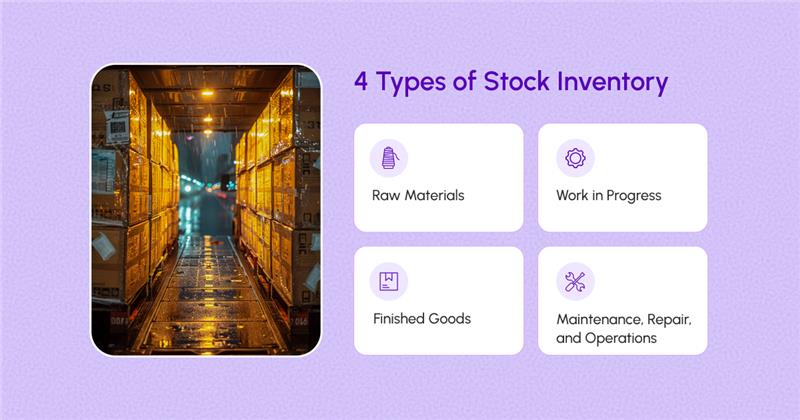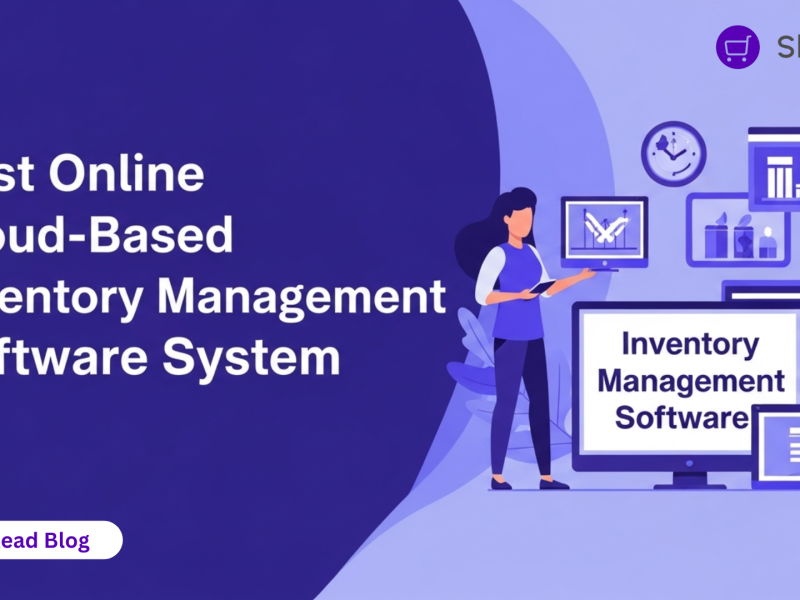Table of Contents
Managing inventory in the right way is important for a successful business. Whether you are a manufacturer, retailer, or operating a warehouse, understanding the different types of stock inventory can save you time, money, and confusion.
Here, it becomes necessary to know about the 4 types of stock inventory. Along with how they affect your operations, and how smart systems like inventory management software, warehouse inventory management software, and barcode inventory systems can make the process easier.
What is Stock Inventory?
Stock inventory means the raw materials, components, finished goods, or supplies a business holds for making or selling products. These goods are counted valuable and are crucial for revenue generation.
For small and medium-sized businesses, especially, managing this inventory with tools like small business inventory management systems or free inventory software can be a game-changer.
Why Understanding Inventory Types Matters
Knowing the different types of inventory allows you to control what you stock, minimise waste, avoid overstocking, and increase profits. It also makes inventory control more accurate when using systems like a warehouse management system (WMS) or inventory software with barcode scanner.
The 4 Types of Stock Inventory

Let’s break down the primary types of inventory every business needs to manage:
1. Raw Materials Inventory
Raw materials are the basic components used to produce finished goods.
Features:
- Directly used in manufacturing.
- Tracked through Stock management software.
- Requires accurate planning.
Why It Matters:
Managing raw materials efficiently avoids delays in production and reduces waste. Many businesses use stock management software to track raw materials, especially those that spoil quickly.
2. Work-In-Progress (WIP) Inventory
This refers to partially finished goods that are still in the production process.
Features:
- Often harder to track.
- Requires inventory billing software that works well with each stage of production.
Why It Matters:
Neglecting WIP inventory leads to operational confusion. With a smart inventory system for small business, companies can track progress in real time.
3. Finished Goods Inventory
These are products that are ready to be sold.
Features:
- Sold to customers.
- Tracked via stock inventory reports.
- Displayed on eCommerce platforms or in retail stores.
Why It Matters:
This is where your profit lies. Accurate Stock inventory management software ensures quick updates and reorders, especially in businesses with high sales turnover.
4. Maintenance, Repair, and Operations (MRO) Inventory
These are goods used to support operations but are not a part of the finished product.
Features:
- Often overlooked.
- Easily tracked with warehouse software or WMS.
Why It Matters:
Even though MROs don’t generate revenue, their shortage can disrupt the entire business. With the right Stock Inventory software free version, businesses can automate this tracking.
Beyond the Basics – Specialised Inventory Types
While the above four are core, there are other inventory categories businesses might encounter:
- Safety Stock: Extra stock kept to avoid running out.
- Cycle Inventory: Regularly restocked items.
- Seasonal Inventory: Stock kept for specific times of the year.
These types can also be managed with robust stock Inventory management systems that provide real-time updates.
Smart Tools to Manage Inventory
Now that we know the types, how do we manage them efficiently? That’s where systems like Stock Inventory software and barcode inventory systems become useful.
1. Inventory Control Through Software
Inventory control is the process of maintaining the right level of stock. It includes ordering, storing, and using inventory efficiently.
Using a barcode inventory system helps track each item’s location, batch, and movement.
2. Warehouse Management System (WMS)
A warehouse management system optimiss space and operations in your warehouse. Whether you use high-end tools or free inventory software, the right WMS helps you:
- Track product movement
- Maintain stock levels
- Automate alerts for low stock
3. Inventory Billing Software
Many businesses also use inventory billing software to sync stock updates with sales. This ensures the what’s sold is immediately taken out of the inventory.
4. Inventory Management Software Free for Small Businesses
For small and growing businesses, cost matters. Shopaver’s inventory management software free tools (which is almost free) offer strong functionality — from barcode scanning to performance tracking— at almost no cost.
Barcode Systems – Your Smartest Inventory Partner
A barcode inventory system speeds up stock tracking and prevents errors. Each product is labelled with a barcode, and scanners enters real-time data into your system.
Top benefits:
- Accuracy
- Speed
- Integration with stock management software
- Easy bulk uploads
When paired with inventory software with barcode scanner, it becomes the backbone of modern warehouse operations.
Inventory Systems for Small Business
Small businesses require a flexible, affordable, and easy-to-use system. A few must-have features include:
- Real-time tracking
- Auto alerts
- Mobile access
- Basic analytics
- Integration with billing
Restaurant Inventory Management Software
Restaurants have unique inventory challenges, items with a short shelf life, fluctuating demand, and limited storage.
A good restaurant inventory management software can:
- Track material usage
- Alert low-stock items
- Forecast food demand
- Sync with billing
Choosing the Right Stock Management Software
Whether you’re in retail, Food & Beverages, or warehousing, choosing the right stock management software is crucial. Look for these features:
- Scalability
- Barcode integration
- Warehouse visibility
- Mobile support
Even a free inventory software can offer many of these features.
Understanding the 4 types of stock inventory — Raw Materials, Work-In-Progress, Finished Goods, and MRO, helps build a strong foundation for your operations.
Integrated with tools like inventory control systems, warehouse inventory management software, and barcode inventory systems, businesses can achieve higher efficiency, reduced costs, and better customer satisfaction.
From startups to enterprises, you can get almost inventory management software free that fits your needs.
Managing inventory can make or break a retail business, and Shopaver simplifies it for you. Its powerful inventory tools let you track stock in real-time, avoid overstocking or shortages, and make product categorisation easy.From automated low-stock alerts to quick stock updates, Shopaver ensures you always stay in control.
Whether you sell online or in-store, our solution adapts to your business size and pace, giving you full visibility across all your products in one place. With Shopaver, inventory isn’t just managed, it’s optimised.
FAQs
1. How does inventory management software work?
Inventory management software automates the tracking of stock levels, sales, orders, and deliveries. It helps businesses manage inventory in real-time, set reorder points, and generate accurate reports for better decision-making.
2. Can inventory management reduce losses?
Yes. By minimising overstocking, avoiding stockouts, and reducing the chances of theft or misplacement, a good inventory system lowers inventory-related losses.
3. Is inventory management useful for small businesses?
Absolutely. Small businesses benefit from better stock control, reduced waste, and improved efficiency, leading to higher profitability and smoother operations.

A passionate writer who creates engaging content that connects with the audience.



